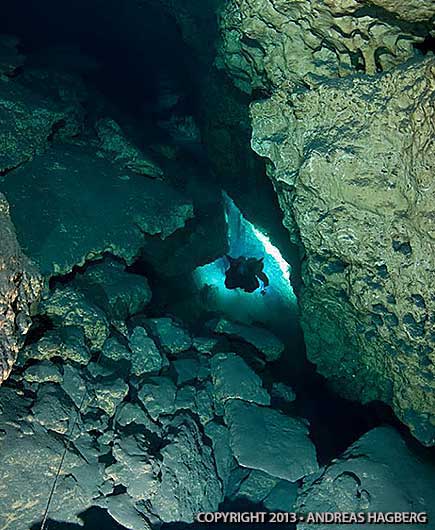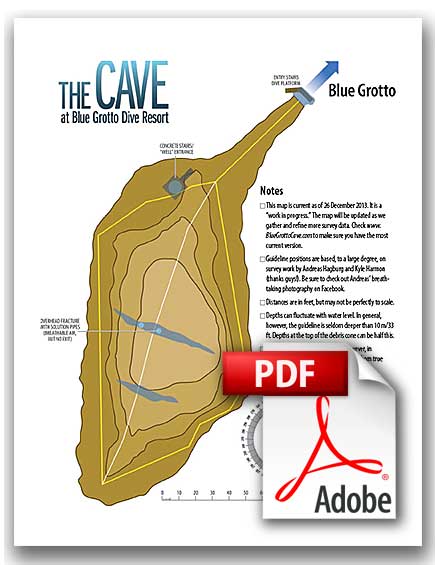The Blue Grotto most divers never knew existed

What makes this cave unique?

Even the most remote areas of north-central Florida’s popular cave diving sites bear the scars of decades of diver traffic. Scrape marks on walls and gouges in floors are something we’ve all become so accustomed to, few really know what an untouched, unblemished cave really looks like.
What sets The Cave at Blue Grotto apart is not only that it’s a site few get to see, but the fact in remains in as close to its natural state as possible. The rock formations are fragile. Virtually every surface is covered by a deep, undisturbed layer of silt.
Cave divers often think of a silty or muddy cave as an ugly cave when, in fact, that’s only because of all the gouges, hand prints and fin prints. When a deep layer of silt bears none of these blemishes, it can be surprisingly beautiful.
The guide corps responsible for maintaining the cave is committed to preserving this unique resource. The guides limit access, and make sure only those who possess superlative skills and abilities are allowed to enter.
Lots of distinct features

The cave consists of a large room, roughly the length and width of a football field. Its most prominent feature is a large debris cone, rising nearly to the ceiling and reaching outward almost to the walls.
The debris cone creates a sense that you are actually swimming through a circular tunnel around it. Despite this, there is a permanent guideline that will take you across the top of the debris cone (see map below). In the middle of this line is an overhead fracture. Inside this fracture is an air space, where you can stick your head up and see out through one of the solution pipes.
It's also possible to surface inside the “well.” Until recently, this shaft provided the only human-accessible entrance to the cave. As you will see, this was not a lot of fun. The newly improved natural entrance makes things a lot more enjoyable.
Part of the rebirth of Blue Grotto

If you’ve not been to Blue Grotto in the past few months, the changes you are going to see will blow you away. Since purchasing the property in 2013, the new owner has invested several hundred thousand dollars into upgrades and improvements.
Among the features in place right now are brand-new covered shelters (pavilions), a large deck right at the water’s edge, and a new rental and fill station. The next few weeks will see the opening of the significantly larger, more comfortable bathhouse, paving of the parking area and opening of the new rental cottages.
Improvements coming in the near future include a swimming pool and refurbished dive center. Blue Grotto has also taken steps to improve the overall water quality and clarity.
The opening of the cave for guided dives and the new features in place for doing so are just part of an ongoing program designed to make Blue Grotto north-central Florida’s premier dive destination.
Getting ready for visitors

The cave the new owner of Blue Grotto inherited was far from ready for divers. The “well” entrance had fallen into disrepair, and the natural entrance was clogged with mud and debris — and difficult to get to.
To remedy this, management brought in a backhoe, removed a dump truck load of mud and trash, then built a dive platform, stairs leading to it and a lockable gate. Meanwhile, local cave instructor Max Kuznetsov replaced over 175 m/575 ft of 20-year-old guideline with brand-new, 6.5 mm/0.25 in gold line. Other members of the guide corps removed most of what little trash there was in the cave — mostly leftover debris from various attempts to build an entry way at the bottom of the “well.”
In October, 2013, photographer Andreas Hagberg and his friends not only took the photos you see here, they also did an initial survey of the cave, which was used as the basis for the map. The final step in the process was the creation of this website by the guides, so that interested divers could learn more about this unique resource.
Get to know the cave before you dive it

To help visitors better visualize the layout of the cave prior to diving it, the guides have put together this four-color map showing its key features. Note the gold line that runs the entire circumference of the cave and the white line that runs across the top of the debris cone. Note also the approximate location of the “well” and the two solution pipes.
This map is based on an initial survey done by Andreas Hagberg, Kyle Harmon and Kirill Egorov in October, 2013. It is a work in progress. As we continue to gather survey data, we expect the map to improve in detail and accuracy. Be sure to check back regularly for updated versions.
It’s a normal standard of practice to ask that those who possess cave maps to keep them to themselves, so that the maps do not tempt untrained divers to do something foolish. In this case, however, you have a cave located on privately owned land, monitored regularly and secured behind a locked gate. This being the case, feel free to share this map as you see fit. Download map.

